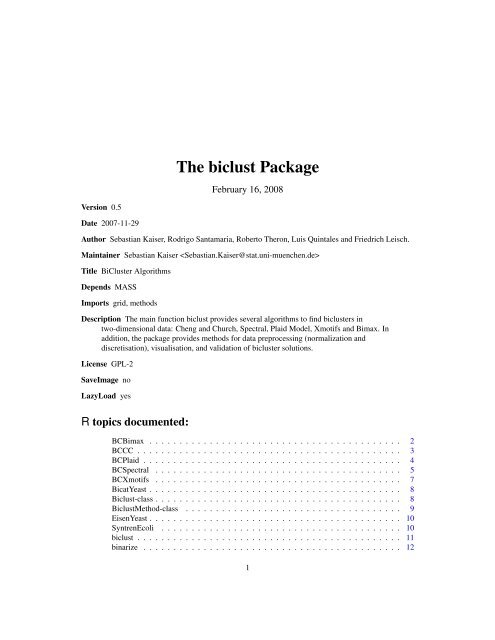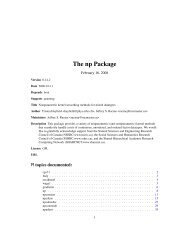The biclust Package - NexTag Supports Open Source Initiatives
The biclust Package - NexTag Supports Open Source Initiatives
The biclust Package - NexTag Supports Open Source Initiatives
Create successful ePaper yourself
Turn your PDF publications into a flip-book with our unique Google optimized e-Paper software.
BCCC 3Examplestest
4 BCPlaidExamplestest
BCSpectral 5ValueReturns an Biclust object.Author(s)Adaptation of original code from Heather Turner from Rodrigo Santamaria 〈rodri@usal.es〉. 〈rodri@usal.es〉ReferencesHeather Turner et al, "Improved <strong>biclust</strong>ering of microarray data demonstrated through systematicperformance tests",Computational Statistics and Data Analysis, 2003, vol. 48, pages 235-254.Lazzeroni and Owen, "Plaid Models for Gene Expression Data", Standford University, 2002.Examples#Random matrix with embedded <strong>biclust</strong>ertest
BCXmotifs 7BCXmotifs<strong>The</strong> Xmotifs Bicluster algorithmDescriptionUsagePerforms XMotifs Biclustering based on the framework by Murali and Kasif (2003). Searches fora submatrix where each row as a similar motif through all columns. <strong>The</strong> Algorihm needs a discretmatrix to perform.## S4 method for signature 'matrix, BCXmotifs':<strong>biclust</strong>(x, method=BCXmotifs(), ns=10, nd=10, sd=5, alpha=0.05, number=100)ArgumentsxmethodnsndsdalphanumberData Matrix.Here BCXmotifs, to perform Xmotifs algorithmNumber of rows choosen.Number of repetitions.Sample size in repetitions.Scaling factor for column result.Number of <strong>biclust</strong>er to be found.ValueExtendsReturns an object of class Biclust.Class "BiclustMethod", directly.Author(s)Sebastian Kaiser 〈sebastian.kaiser@stat.uni-muenchen.de〉ReferencesMurali, T. & Kasif, S. Extracting Conserved Gene Expression Motifs from Gene Expression DataPacific Symposium on Biocomputing, sullivan.bu.edu, 2003, 8, 77-88See Also<strong>biclust</strong>, Biclust
8 Biclust-classExamplesdata(BicatYeast)x
BiclustMethod-class 9SlotsDetailsObjects of class Biclust have the following slots:Parameters: Saves input Parameters in a listRowxNumber: Logical Matrix which contains 1 in [i,j] if Row i is in Bicluster jNumberxCol: Logical Matrix which contains 1 in [i,j] if Col j is in Bicluster iNumber: Number of BiclusterRowxNumber and NumberxCol are named after the arrangement of the data they contain. <strong>The</strong>column results are transposed in order to ensure a easy processing.Author(s)See AlsoSebastian Kaiser 〈sebastian.kaiser@stat.uni-muenchen.de〉<strong>biclust</strong>, BiclustMethod-classExamplesBiclustMethod-class<strong>The</strong> BiclustMethod Virtual ClassDescriptionBiclustMethod is the virtual class structure for algorithms provided in the package. In order to usethe <strong>biclust</strong>() function a algorithm has to have a class inherit from here.AlgorithmsCurrently 5 classes inherit from BiclustMethod: BCCC, BCXmotifs, BCPlaid, BCSpectral,BCBimaxAuthor(s)See AlsoSebastian Kaiser 〈sebastian.kaiser@stat.uni-muenchen.de〉<strong>biclust</strong>, Biclust-class, BCCC, BCXmotifs, BCPlaid, BCSpectral, BCBimax, BiclustMethodclass
10 SyntrenEcoliExamplesEisenYeastEisen YeastDescriptionMicroarray data matrix for 80 experiments with Saccharomyces Cerevisiae organism by Eisen Lab.Usagedata(EisenYeast)Format<strong>Source</strong>Data frame with information about the expression levels of 6221 genes over 80 conditions. Missingvalues have been imputed unsin k-nearest neighbor averaging implemented in impute.knn() fromlibrary ’impute’ (using default k=10). Gene names follow ORF (<strong>Open</strong> Reading Format) notation.Eisen Lab at http://rana.lbl.gov/EisenData.htmSyntrenEcoliSynTReN E. coliDescriptionUsageSynthetic microarray data matrix generated by Syntren for 20 experiments using 200 genes fromTranscription Regulatory Network of Shen-Orr et al. (2002).data(SyntrenEcoli)Format<strong>Source</strong>Data structure with information about the expression levels of 200 genes over 20 conditions. Conditionsare named as C1... C20SynTReN software can be downloaded at http://homes.esat.kuleuven.be/ kmarchal/SynTReN/index.html
iclust 11ReferencesShen-Orr et al., "Network motifs in the transcriptional regulation network of Escherichia coli",Nature Genetics 2002, volume 31, pages 64-68.Tim Van den Bulcke et al., "SynTReN: a generator of synthetic gene expression data for design andanalysis of structure learning algorithms", BMC Bioinformatics, 2006, volume 7, number 43.<strong>biclust</strong><strong>The</strong> <strong>biclust</strong> MethodDescription<strong>The</strong> function <strong>biclust</strong> is the main function of the package. It calculates the <strong>biclust</strong>er in a datamatrix using the algorithm specified in the method-argument. Currently the package contains 5different methods for the use in <strong>biclust</strong>. For each algorithm see the class help files for furtherdetails. For some algorithms preproccessing is necessary, e.g. BCBimax only runs with a logicalmatrix.Usage## S4 method for signature 'matrix, BiclustMethod':<strong>biclust</strong>(x,method,...)## S4 method for signature 'matrix, character':<strong>biclust</strong>(x,method,...)ArgumentsxmethodData matrix.An object of class "BiclustMethod" or a character string with the name ofa "BiclustMethod"-class.... Additional Parameters of the "BiclustMethod"ValueReturns an object of class Biclust.Author(s)Sebastian Kaiser 〈sebastian.kaiser@stat.uni-muenchen.de〉See AlsoBiclust-class, BCCC, BCXmotifs, BCPlaid, BCSpectral, BCBimax, BiclustMethodclass
12 binarizeExamplestest
ubbleplot 13Examplesdata(BicatYeast)m1=binarize(BicatYeast)m2=binarize(BicatYeast, 0.2)m3=binarizeByPercentage(BicatYeast, 5)densityOnes(m3)densityOnes(m2)densityOnes(m1)drawHeatmap(BicatYeast)drawHeatmap(m1)drawHeatmap(m2)drawHeatmap(m3)bubbleplotBubbleplotDescriptionDraws a bubble plot where each <strong>biclust</strong>er is represented as a circle (bubble). Color represents the <strong>biclust</strong>erset to which <strong>biclust</strong>er pertains (up to three <strong>biclust</strong>er sets can be represented simultaneously).Brightness representes the <strong>biclust</strong>er homogeneity (darker, less homogeneous). Size represents thesize of the <strong>biclust</strong>er, as (number of genes)x(number of conditions). Location is a 2D-projection ofgene and condition profiles.Usagebubbleplot(x, bicResult1, bicResult2=NULL, bicResult3=NULL, projection="mean", showArgumentsxbicResult1bicResult2bicResult3projectionshowLabels<strong>The</strong> data matrix from which <strong>biclust</strong>ers were identified.BiclustResult object with a <strong>biclust</strong>er result set whose <strong>biclust</strong>ers will be drawn ingreen.BiclustResult object with an optional second <strong>biclust</strong>er result set. Will be drawnin red (default NULL)BiclustResult object with an optional third <strong>biclust</strong>er result set. Will be drawn inblue (default NULL)Projection algorithm used to position bubbles. Allowed projections are ’mean’,’isomds’ and ’cmdscale’ (default ’mean’). See details section for a broader explanation.If ’TRUE’, puts a label over each bubble that tells the number within the corresponding<strong>biclust</strong>er result (default ’FALSE’).
14 bubbleplotDetailsPosition of circles depend on a 2D projection of the multidimensional point formed by rows andcolumns present in the <strong>biclust</strong>er. For example, if we have a 3x3 matrix to analyze and we finda <strong>biclust</strong>er with rows 1 and 3 and columns 2 and 3, the corresponding multidimensional pointwill be p=(1,0,1,0,1,1). For this example, ’mean’ projection will map the <strong>biclust</strong>er with the pointx=(1+3)/2=2 and y=(2+3)/2=2,5. Other projections will take the point p and project it following thecorresponding algorithms (see the corresponding help pages for details)NoteBubbleplot 2D-projection, as any multidimensional scaling, loses information, trying to take themain relationships and trends of n-dimensional data. Thus, locations and intersections betweenbubbles-<strong>biclust</strong>ers are only an estimate of its similarity. This visualization should be used just as ahelp to understand overall behavior of <strong>biclust</strong>ering methods, detect trends and outliers, etc.Author(s)Rodrigo Santamaria 〈rodri@usal.es〉See AlsodrawHeatmap for single representation of <strong>biclust</strong>ers inside data matrix.parallelCoordinates for single representation of <strong>biclust</strong>ers as lines of gene or condition profiles.cmdscale, isomds for multidimensional scaling.plot for other point representations.Examples#Simplified yeast microarray data## Not run:data(BicatYeast)set.seed(1)bics1
coherence 15coherenceCoherence measuresDescriptionUsageDifferent prelilminary measures of how much constant or (additive, multiplicative, sign) coherent a<strong>biclust</strong>er is, following Madeira and Oliveira classification of <strong>biclust</strong>ers.constantVariance(x, resultSet, number, dimension="both")additiveVariance(x, resultSet, number, dimension="both")multiplicativeVariance(x, resultSet, number, dimension="both")signVariance(x, resultSet, number, dimension="both")ArgumentsxresultSetnumberdimension<strong>The</strong> data matrix from which <strong>biclust</strong>ers were identifiedBiclustResult object with a <strong>biclust</strong>er result set where is the <strong>biclust</strong>er to measureNumber of the <strong>biclust</strong>er withing the result set"both" for determining overall variance, "row" for gene variance and "col" forcolumn variance. Default "both"DetailsNoteReturns the corresponding variance of genes or conditions as the average of the sum of euclideandistances between all rows and/or columns of the <strong>biclust</strong>er. For additive, multiplicative and signvariance first a transformation of the <strong>biclust</strong>er is done, so variance is computed on a matrix thatreflects difference, rest or change of sign between rows, columns or both.<strong>The</strong> lower the value returned, the more constant or coherent the <strong>biclust</strong>er is. If the value returned is0, the <strong>biclust</strong>er is ideally constant or coherent. Usually, a value above 1-1.5 is enough to determinethe <strong>biclust</strong>er is not constant or coherent.<strong>The</strong>re are preliminary measures for coherence. Since transformations are different, measures arenot normalized and comparison between, for example, additive and multiplicative variance is notmeaningful. Only comparisons between different measures of the same kind of variance are reliableby now.Author(s)See AlsoRodrigo Santamaria 〈rodri@usal.es〉
16 discretizeExamples#Simplified yeast microarray datadata(BicatYeast)set.seed(1)bics1
drawHeatmap 17Examples#Discretize yeast microarray datadata(BicatYeast)discretize(BicatYeast[1:10,1:10])drawHeatmapDraw HeatmapDescriptionUsageDraws a microarray data matrix as a heatmap, with rows and colums reordered so the rows andcolumns of the input <strong>biclust</strong>er will be at top-left of the matrix.drawHeatmap(x,bicResult=NULL,number=NA)ArgumentsxbicResultnumber<strong>The</strong> data matrix where the <strong>biclust</strong>er is to be drawn.BiclustResult object with a <strong>biclust</strong>er result set. If this value is set to NULL, thedata matrix is drawn as a heatmap, without any reordering. Default NULL.Bicluster to be drawn from the result set ’bicResult’. If bicResult is set to NULL,this value is ignored. Default NAAuthor(s)See AlsoRodrigo Santamaria 〈rodri@usal.es〉bubbleplot for simultaneous representation of <strong>biclust</strong>ers.parallelCoordinates for single representation of <strong>biclust</strong>ers as lines of gene or condition profiles.Examples#Random 100x50 matrix with a single, up-regulated 10x10 <strong>biclust</strong>ers2=matrix(rnorm(5000),100,50)s2[11:20,11:20]=rnorm(100,3,0.3)set.seed(1)bics
18 parallelCoordinatesjaccardindJaccardindDescriptionAn adaption of the Jaccard Index for clustering is calculated.Usagejaccardind(bicres1,bicres2)Argumentsbicres1bicres2A object of class BiclustA object of class BiclustDetails<strong>The</strong> function calculates the percentage of datapoints in the same <strong>biclust</strong>er structure from all datapointsat least included in one <strong>biclust</strong>er.Author(s)Sebastian Kaiser 〈sebastian.kaiser@stat.uni-muenchen.de〉Examples## Not run:data(BicatYeast)res1
writeBiclusterResults 19ArgumentsxbicResult<strong>The</strong> data matrix of the <strong>biclust</strong>er to be drawnBiclustResult object with a <strong>biclust</strong>er result setnumber Bicluster to be drawn from the result set ’bicResult’plotConditionsIf ’TRUE’, condition profiles are drawn, so each line represents one of the conditionsin the <strong>biclust</strong>er. Otherwise, gene profiles are drawn. Default ’TRUE’absoluteLimitsIf ’TRUE’, absolute limits are used, so expression levels from the minimum tothe maximum of the complete data matrix are considered. Otherwise, minimumand maximum are minimum and maximum expression levels grouped in the<strong>biclust</strong>er. Default ’TRUE’Author(s)Rodrigo Santamaria 〈rodri@usal.es〉See AlsodrawHeatmap for alternative representation of <strong>biclust</strong>ers.bubbleplot for simultaneous representation of <strong>biclust</strong>ers.Examples#Random 100x50 matrix with a single, up-regulated 10x10 <strong>biclust</strong>ers2=matrix(rnorm(5000),100,50)s2[11:20,11:20]=rnorm(100,3,0.3)set.seed(1)bics
20 writeBiclusterResultsArgumentsfileNamebicResultbicNamegeneNamesarrayNamesappendPath to the file were <strong>biclust</strong>ers are written.Biclusters results as a Biclust class.Brief description for the <strong>biclust</strong>ering algorithm used.Array of strings with gene (row) names in the analyzed data matrixArray of strings with condition (column) names in the analyzed data matrixIf true, adds the <strong>biclust</strong>er results to previous information in the text file, if itexists. Default false.delimiter delimiter string between gene and condition names. Default " ".Author(s)Rodrigo Santamaria 〈rodri@usal.es〉Examplesdata(BicatYeast)res
Index∗Topic arraybinarize, 12coherence, 15writeBiclusterResults, 19∗Topic classesBiclust-class, 8BiclustMethod-class, 9∗Topic classifBCBimax, 1BCCC, 3BCPlaid, 4BCXmotifs, 7∗Topic clusterBCBimax, 1BCCC, 3BCPlaid, 4BCSpectral, 5BCXmotifs, 7<strong>biclust</strong>, 11bubbleplot, 13coherence, 15discretize, 16drawHeatmap, 17jaccardind, 18parallelCoordinates, 18∗Topic datasetsBicatYeast, 8EisenYeast, 10SyntrenEcoli, 10∗Topic hplotbubbleplot, 13drawHeatmap, 17parallelCoordinates, 18∗Topic manipbinarize, 12writeBiclusterResults, 19∗Topic modelsBCPlaid, 4∗Topic multivariateBCSpectral, 5additiveVariance (coherence), 15BCBimax, 1, 9, 11BCBimax-class (BCBimax), 1BCCC, 3, 9, 11BCCC-class (BCCC), 3BCPlaid, 4, 9, 11BCPlaid-class (BCPlaid), 4BCSpectral, 5, 9, 11BCSpectral-class (BCSpectral), 5BCXmotifs, 7, 9, 11BCXmotifs-class (BCXmotifs), 7BicatYeast, 8Biclust, 2, 3, 7Biclust (Biclust-class), 8<strong>biclust</strong>, 2, 3, 7, 9, 11<strong>biclust</strong>,matrix,BCBimax-method(BCBimax), 1<strong>biclust</strong>,matrix,BCCC-method(BCCC), 3<strong>biclust</strong>,matrix,BCPlaid-method(BCPlaid), 4<strong>biclust</strong>,matrix,BCSpectral-method(BCSpectral), 5<strong>biclust</strong>,matrix,BCXmotifs-method(BCXmotifs), 7<strong>biclust</strong>,matrix,BiclustMethod-method(<strong>biclust</strong>), 11<strong>biclust</strong>,matrix,character-method(<strong>biclust</strong>), 11<strong>biclust</strong>,matrix,function-method(<strong>biclust</strong>), 11Biclust-class, 9, 11Biclust-class, 8<strong>biclust</strong>-method (<strong>biclust</strong>), 11BiclustMethod, 7BiclustMethod(BiclustMethod-class), 921
22 INDEXBiclustMethod-class, 9, 11BiclustMethod-class, 9BiclustResult (Biclust-class), 8Bimax (BCBimax), 1binarize, 12binarizeByPercentage (binarize),12bubble plot (bubbleplot), 13bubbleplot, 13, 17, 19CC (BCCC), 3coherence, 15constantVariance (coherence), 15densityOnes (binarize), 12discretize, 16drawHeatmap, 14, 17, 19E. coli microarray syntheticdata matrix(SyntrenEcoli), 10EisenYeast, 10Escherichia Coly data matrixgenerated by SynTReN(SyntrenEcoli), 10spectral (BCSpectral), 5spectral <strong>biclust</strong>ering(BCSpectral), 5star graph (bubbleplot), 13summary,Biclust-method(Biclust-class), 8SyntrenEcoli, 10turner <strong>biclust</strong>ering (BCPlaid), 4writeBiclusterResults, 19writeBiclusters(writeBiclusterResults), 19Xmotif (BCXmotifs), 7yeast microarray data matrix(EisenYeast), 10yeast microarray reduced datamatrix (BicatYeast), 8heatmap (drawHeatmap), 17jaccardind, 18Kluger <strong>biclust</strong>ering (BCSpectral),5multiplicativeVariance(coherence), 15parallel coordinates(parallelCoordinates), 18parallelCoordinates, 14, 17, 18plaid (BCPlaid), 4plaid model (BCPlaid), 4Saccharomices Cerevisiae datamatrix (EisenYeast), 10Saccharomices Cerevisiaereduced data matrix(BicatYeast), 8show,Biclust-method(Biclust-class), 8signVariance (coherence), 15
















